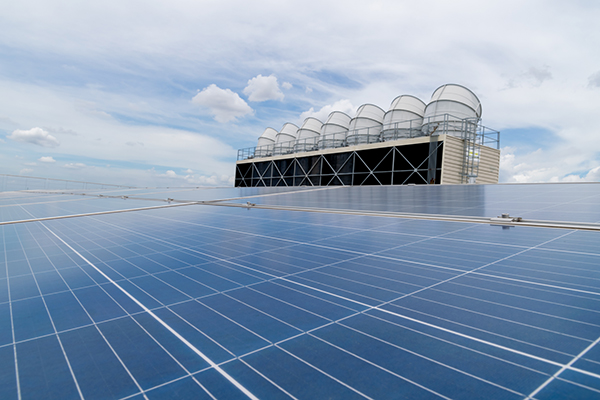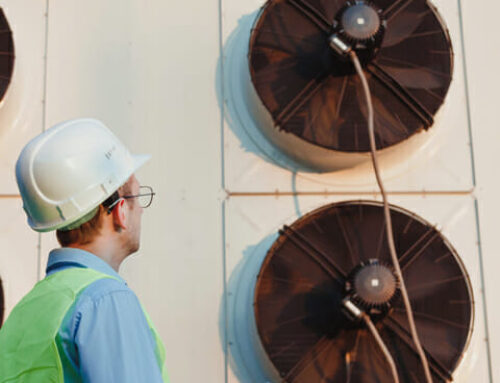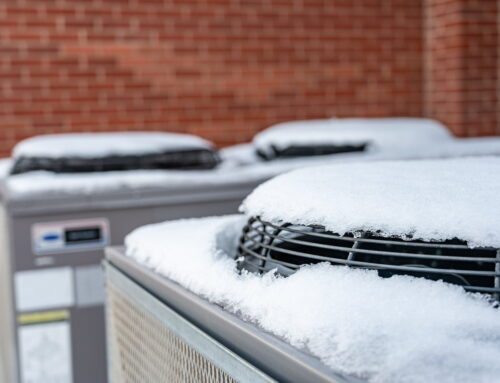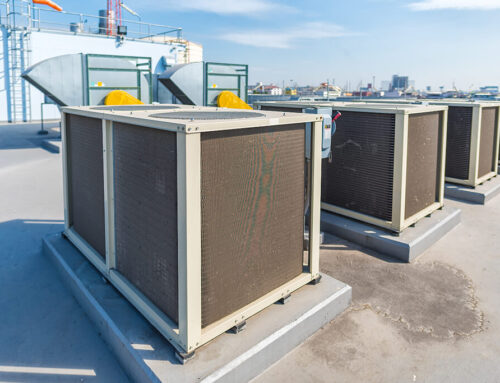The quest for sustainable solutions and technological advancements in climate control, driven by climate change, has led the commercial sector to a pivotal shift, particularly within Heating, Ventilation, and Air Conditioning (HVAC) systems, incorporating thermodynamics. Historically reliant on fossil fuels, these systems are now at the forefront of integrating renewable energy sources, including solar power and wind turbines, through advanced technologies and technological advancements. The transition not only marks a significant step towards reducing carbon footprints but also opens avenues for cost savings, energy performance improvements, and renewable energy integration while managing energy consumption and usage. This exploration into harnessing renewable energy in commercial HVAC applications, including water heating, space heating, and ventilation systems, and grounded in thermodynamics, is not just an environmental imperative but a strategic business move as well.
Exploring Renewable Energy Integration in HVAC
Cost Reduction
Harnessing renewable energy in commercial HVAC applications for space heating, water heating, and reducing power consumption can significantly cut operational costs through thermodynamics. Wind, solar energy, and advanced HVAC systems stand out as the most promising sources. These renewables, like solar energy and wind energy, can power HVAC systems and water heating, reducing reliance on traditional electricity, with the support of energy storage technologies.
The potential for cost savings is immense. For instance, solar panels installed on a building’s roof can generate enough power to run advanced HVAC systems, including air conditioning units during peak hours, enhancing energy efficiency through renewable energy integration and energy storage systems. This not only lowers electricity bills but also reduces demand from the grid during high-use periods, enhancing energy efficiency and renewable energy integration through reduced energy consumption and solar energy utilization.
System Longevity
Integrating renewable energy into HVAC operations can extend system life in commercial buildings and improve air quality. HVAC systems in commercial buildings powered by clean energy face less wear and tear compared to those running on conventional power sources, including air systems. This is because renewable sources, such as solar energy and energy storage systems, often provide a more stable supply of electricity, improving energy efficiency and reducing energy consumption.
The role of smart integration becomes crucial here. By intelligently managing when and how much renewable power, such as solar energy, to use, systems like HVAC operate more efficiently, improving energy efficiency and reducing energy consumption. This leads to fewer breakdowns, longer intervals between maintenance checks, and improved energy efficiency in HVAC systems with renewable energy integration, reducing overall energy consumption.
Retrofitting Challenges
Retrofitting existing HVAC systems in commercial buildings with renewable sources poses challenges but offers rewarding solutions for energy efficiency and reduced energy consumption too.
One major hurdle is compatibility issues between old systems and new technologies, including HVAC, in commercial buildings for energy efficiency and renewable energy integration. However, innovative adapters and interfaces for renewable energy integration, energy efficiency, and energy storage systems are being developed to bridge this gap.
Another challenge in renewable energy integration is upfront costs; installing solar panels or wind turbines requires significant investment in energy efficiency and energy storage systems. But financial incentives like tax credits for energy efficiency, renewable energy integration, HVAC, and energy storage systems help mitigate these expenses.
Solar and Geothermal Power for HVAC Sustainability
Efficiency Rates
Solar-powered HVAC systems convert sunlight into energy. This process is clean and sustainable. They use solar panels to capture energy from the sun. Then, they transform it into power for heating, cooling, and ventilation, enhancing HVAC energy efficiency and integrating renewable energy and energy storage systems.
Geothermal HVAC systems tap into the earth’s stable temperature. They use this to heat and cool buildings efficiently. These systems rely on a network of underground pipes. The HVAC pipes circulate water or refrigerant to exchange heat with the ground, enhancing energy efficiency and enabling renewable energy integration through energy storage systems.
Both methods, focusing on energy efficiency and renewable energy integration in building HVAC systems, are more efficient than traditional fossil fuel-based systems. They produce fewer greenhouse gas emissions too.
Climate Suitability
The effectiveness of solar vs geothermal power in HVAC, considering energy efficiency, renewable energy integration, and energy storage systems, depends on local climate conditions.
Solar power, a form of renewable energy integration, thrives in sunny regions where sunlight is abundant year-round, benefiting from energy efficiency and supported by energy storage systems. Geothermal systems are less dependent on weather conditions. They offer consistent performance regardless of surface temperatures. Choosing between these two often comes down to location specifics, renewable energy integration, energy storage systems, HVAC, and sustainability goals.
Cost-Benefit Analysis
Transitioning to renewable energy requires an initial investment but offers long-term savings.
-
Pros:
-
Lowered carbon footprint
-
Reduced dependency on fossil fuels
-
Decreased operational costs over time due to lower electricity bills, renewable energy integration, energy storage systems, and HVAC improvements.
-
Cons:
-
High upfront cost for installation
-
Geographic limitations might apply, especially for solar cooling solutions
Stakeholders must weigh these factors, including renewable energy integration and HVAC considerations, against their sustainability objectives and financial capacity. Both solar and geothermal energies promise a sustainable future by reducing CO2 emissions significantly compared to traditional energy sources.
Role of Thermodynamics in Green HVAC Design
System Design
Thermodynamics plays a crucial role in the design and renewable energy integration of HVAC systems. It helps engineers create HVAC systems that use energy more efficiently. This is key for green HVAC applications.
Understanding thermodynamic principles allows for better system designs. These designs can manage heat transfer effectively. They ensure that HVAC heating and cooling are done with minimal energy waste.
Heat Transfer
Optimizing heat transfer is vital in green HVAC systems. It ensures buildings stay comfortable without using too much power through HVAC and renewable energy integration.
Materials science has brought innovations to improve this process. New materials help HVAC systems perform better by enhancing how they handle heat and facilitating renewable energy integration. This leads to lower HVAC energy costs and reduced environmental impact.
Material Innovations
Advances in materials science play a significant role in renewable energy integration and HVAC systems here, too. They have led to the development of HVAC components that boost thermodynamic efficiency and renewable energy integration.
For example, new insulation materials in HVAC systems reduce unwanted heat loss or gain, supporting renewable energy integration. Similarly, high-efficiency HVAC compressors use less energy while maintaining performance levels.
Harnessing renewable energy sources like solar and geothermal power for HVAC systems links closely with these advances. By integrating these renewable energies into HVAC system design, we achieve more sustainable energy solutions. These efforts show how crucial understanding thermodynamics and renewable energy integration is when designing eco-friendly HVAC systems.
Advanced Technologies in Renewable Energy for HVAC
Solar Breakthroughs
Photovoltaic (PV) technology has seen significant advancements. These improvements make solar energy more efficient for HVAC systems. Traditional HVAC units use a lot of power. But, with advanced PV systems, commercial buildings can enjoy better HVAC temperature control while using less electricity from renewable energy sources.
Solar-powered HVAC units convert sunlight into energy. This process is becoming more efficient thanks to new technologies in renewable energy and HVAC. Buildings can now rely on the sun, a renewable energy source, for heating, ventilation, air conditioning (HVAC), and even water heating.
Smart Grids Impact
Smart grids are changing how renewable energy integrates with HVAC operations. They allow for smoother operation of renewable energy systems, including HVAC, within commercial spaces. This means that businesses can use renewable energy sources like wind turbines or solar panels together with their HVAC systems without issues.
The smart grid technology ensures that energy from renewables is used when it’s most needed for HVAC systems. It also helps in reducing waste heat, improving indoor air quality, and enhancing HVAC systems with renewable energy.
Heat Pump Innovations
High-efficiency heat pumps powered by renewables are revolutionizing space heating and cooling in the energy and HVAC industry. Unlike traditional HVAC systems, these pumps provide consistent air quality using less energy.
These innovative HVAC heat pumps work well with other renewable energy sources like wind power and PV systems. They offer an eco-friendly, renewable energy solution to climate change challenges faced by the commercial sector, focusing on HVAC systems.
Energy Storage Solutions in Commercial Buildings
Battery Systems
Battery storage systems play a crucial role. They help balance HVAC energy demands in commercial buildings. These systems store electricity when demand is low. Then, they supply power during peak hours.
This approach leads to significant energy savings. It reduces the strain on the grid too. Building owners see lower energy costs as a result.
Thermal Technologies
Thermal storage technologies offer another way to manage loads. They absorb or store heat during off-peak times for use later in HVAC systems, utilizing renewable energy. This can greatly reduce the need for active HVAC cooling or heating during high-demand periods, leveraging renewable energy.
Such HVAC technologies lead to reduced energy consumption and cost savings. They make HVAC systems more efficient at handling fluctuations in energy usage.
Flywheel Storage
Flywheel energy storage improves system responsiveness and reliability. It stores kinetic energy that can be quickly converted into electricity.
This technology supports HVAC operations by providing immediate power supply from renewable energy during sudden demand spikes or outages.
It enhances overall efficiency and stability of HVAC energy use in commercial structures.
Maximizing HVAC Efficiency with Renewable Energy
Optimizing Airflow
Optimizing airflow and temperature control is crucial. Using renewable energy sources can significantly improve this process. Solar panels, a form of renewable energy, for instance, can power fans and ventilation systems directly. This approach leads to significant energy savings.
Renewable energy offers a greener way to keep buildings comfortable. Wind energy could also be harnessed to supplement power needs for HVAC systems. Both renewable energy methods reduce reliance on traditional electricity, cutting costs and carbon emissions.
Demand Response Systems
Demand response systems play a big role in enhancing HVAC efficiency and integrating renewable energy. By adjusting the consumption of energy based on supply availability, these systems ensure efficient operation without wasting resources. They are particularly effective when integrated with renewable energy sources like solar or wind power.
This strategy not only optimizes energy performance but also contributes to overall grid stability. It’s a smart way to manage peak load times with renewable energy while ensuring buildings stay comfortable.
Variable Refrigerant Flow
Implementing variable refrigerant flow (VRF) systems is another step towards maximizing efficiency. VRF technology allows for precise temperature control in different zones of a building using less energy than traditional methods.
The flexibility and scalability of VRF systems make them ideal for commercial applications where space usage varies greatly throughout the day or week—resulting in immense potential for energy savings and environmental benefits.
Government Policies Supporting Renewable HVAC Integration
Tax Incentives
Government policies play a pivotal role in the adoption of renewable energy in commercial HVAC applications. Financial incentives such as tax rebates and credits for renewable energy are significant motivators for businesses. These incentives lower the initial investment costs, making it more feasible for companies to switch to green technologies and renewable energy.
For example, a business installing solar panels for its HVAC system to utilize renewable energy may receive a tax credit covering 30% of the installation cost. This reduction in renewable energy costs can translate into substantial savings, encouraging more businesses to make the transition. Such financial benefits not only support individual companies but also promote widespread adoption of renewable energy across industries.
Building Codes
Building codes and standards directly influence how commercial buildings integrate renewable energy into their HVAC systems. These regulations ensure that new constructions or renovations meet certain environmental criteria, pushing for greener practices and renewable energy use industry-wide.
In some regions, building codes mandate the inclusion of renewable energy sources for heating and cooling purposes. This requirement fosters innovation within the renewable energy sector, leading to advancements in technology and efficiency. As these standards become stricter over time, they drive continuous improvement and sustainability in commercial HVAC applications, incorporating renewable energy.
International Influence
International agreements have a considerable impact on national policies regarding renewable energy use in commercial buildings. By committing to global targets on reducing carbon emissions, countries adopt measures that encourage or even require the use of renewable energy sources.
Programs stemming from these agreements provide additional support through funding opportunities or technical assistance aimed at achieving these goals within domestic markets, focusing on renewable energy.
Case Studies on Successful Renewable HVAC Applications
Solar Transition
A commercial building in California made headlines. It transitioned to a fully solar-powered HVAC system. This move drastically cut energy costs and carbon footprint.
The process involved installing high-efficiency solar panels on the roof for renewable energy. The building now generates more renewable energy power than it uses during peak sunlight hours. Excess energy is stored or sold back to the grid, showcasing a smart use of renewable resources.
Geothermal Efficiency
Geothermal energy heating and cooling have proven effective in large-scale facilities like schools and hospitals. A university in the Midwest adopted this energy technology for its campus buildings, leading to significant savings.
By utilizing the stable temperatures underground, the system provides year-round comfort with less energy consumption compared to traditional methods. This case study highlights geothermal energy’s potential for large properties seeking sustainable solutions.
Policy Impacts
Government policies play a crucial role in promoting energy-efficient green HVAC technologies. Incentives and rebates encourage businesses to invest in renewable energy solutions.
One notable impact was seen when a state introduced tax credits for renewable energy HVAC installations. This led to an uptick in projects adopting solar and geothermal energy systems across commercial sectors. These real-world examples demonstrate how energy policy can drive change towards sustainability.
Closing Thoughts
Harnessing renewable energy in commercial HVAC systems isn’t just a trend; it’s the future knocking on our doors. From diving deep into how renewables can seamlessly integrate with HVAC, exploring solar and geothermal power, to understanding the role of thermodynamics, energy, and cutting-edge technologies, we’ve covered the gamut. The journey through energy storage solutions, efficiency maximization strategies, supportive government policies, and real-world success stories paints a clear picture: the shift towards green HVAC is not only possible but imperative. It’s about making smarter energy choices for our planet while also cutting costs in the long run.
So, what’s your next move? Whether you’re a business owner eyeing energy cost reductions or an eco-conscious individual advocating for sustainable practices, the time to act is now. Let’s not wait for tomorrow to make the energy changes we need today. Dive into renewable energy HVAC solutions and be part of the revolution that’s setting the stage for a greener, more sustainable future. Ready to take the leap? Your planet will thank you.






